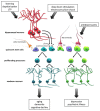The therapeutic potential of endogenous hippocampal stem cells for the treatment of neurological disorders
- PMID: 23372544
- PMCID: PMC3556583
- DOI: 10.3389/fncel.2013.00005
The therapeutic potential of endogenous hippocampal stem cells for the treatment of neurological disorders
Abstract
While it is now well-established that resident populations of stem and progenitor cells drive neurogenesis in the adult brain, a growing body of evidence indicates that these new neurons play a pivotal role in spatial learning, memory, and mood regulation. As such, interest is gathering to develop strategies to harness the brain's endogenous reservoir of stem and progenitor cells, with the view that newborn neurons may help overcome the loss of neural and cognitive function that occurs during neurodegenerative disease and psychiatric illness. Here we review evidence for the presence of endogenous stem cell populations in the adult hippocampus, especially large pools of latent stem and precursor cells, and the ways in which these populations can be stimulated to produce new neurons. While the translation of this research from animal models to human application is still in its infancy, understanding in detail the cellular and molecular mechanisms that regulate endogenous neurogenesis, offers the potential to use this innate reservoir of precursors to produce neurons that may be able to mitigate against cognitive decline and mood disorders.
Keywords: endogenous adult neurogenesis; hippocampus; neural precursor cell; neural stem cell; stem cell therapy.
Figures

References
-
- Australian Bureau of Statistics. (2007). National Survey of Mental Health and Wellbeing: Summary of Results. Canberra, ACT: ABS
LinkOut - more resources
Full Text Sources
Other Literature Sources
Research Materials

